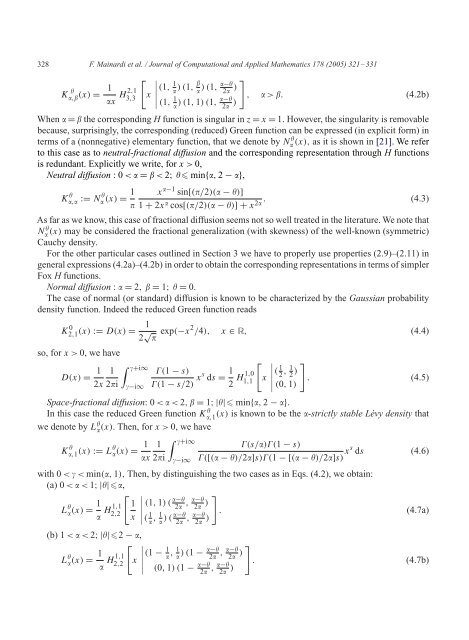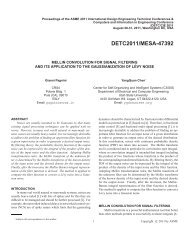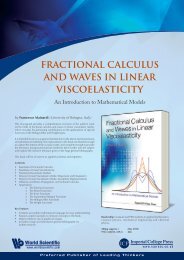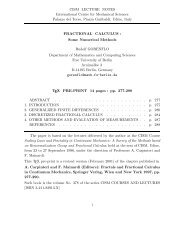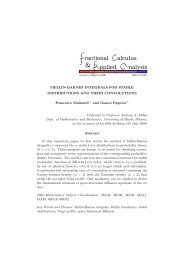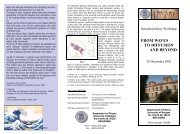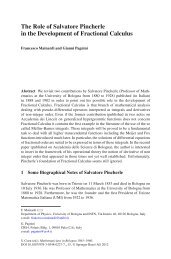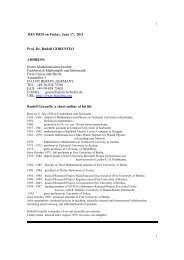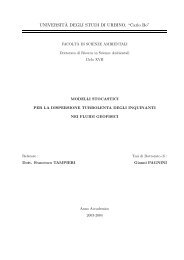Fox H functions in fractional diffusion - FRActional CALculus ...
Fox H functions in fractional diffusion - FRActional CALculus ...
Fox H functions in fractional diffusion - FRActional CALculus ...
You also want an ePaper? Increase the reach of your titles
YUMPU automatically turns print PDFs into web optimized ePapers that Google loves.
328 F. Ma<strong>in</strong>ardi et al. / Journal of Computational and Applied Mathematics 178 (2005) 321–331<br />
K <br />
<br />
, (x) =<br />
1 2,1<br />
H3,3 x<br />
x<br />
<br />
<br />
<br />
<br />
<br />
(1, 1 −<br />
)(1, )(1, 2 )<br />
(1, 1 −<br />
)(1, 1)(1, 2 )<br />
, > . (4.2b)<br />
When = the correspond<strong>in</strong>g H function is s<strong>in</strong>gular <strong>in</strong> z = x = 1. However, the s<strong>in</strong>gularity is removable<br />
because, surpris<strong>in</strong>gly, the correspond<strong>in</strong>g (reduced) Green function can be expressed (<strong>in</strong> explicit form) <strong>in</strong><br />
terms of a (nonnegative) elementary function, that we denote by N (x), as it is shown <strong>in</strong> [21].We refer<br />
to this case as to neutral-<strong>fractional</strong> <strong>diffusion</strong> and the correspond<strong>in</strong>g representation through H <strong>functions</strong><br />
is redundant.Explicitly we write, for x>0,<br />
Neutral <strong>diffusion</strong> :0< = < 2; m<strong>in</strong>{, 2 − },<br />
K , := N 1 x<br />
(x) =<br />
<br />
−1 s<strong>in</strong>[(/2)( − )]<br />
1 + 2x . (4.3)<br />
cos[(/2)( − )]+x2 As far as we know, this case of <strong>fractional</strong> <strong>diffusion</strong> seems not so well treated <strong>in</strong> the literature.We note that<br />
N (x) may be considered the <strong>fractional</strong> generalization (with skewness) of the well-known (symmetric)<br />
Cauchy density.<br />
For the other particular cases outl<strong>in</strong>ed <strong>in</strong> Section 3 we have to properly use properties (2.9)–(2.11) <strong>in</strong><br />
general expressions (4.2a)–(4.2b) <strong>in</strong> order to obta<strong>in</strong> the correspond<strong>in</strong>g representations <strong>in</strong> terms of simpler<br />
<strong>Fox</strong> H <strong>functions</strong>.<br />
Normal <strong>diffusion</strong> : = 2, = 1; = 0.<br />
The case of normal (or standard) <strong>diffusion</strong> is known to be characterized by the Gaussian probability<br />
density function.Indeed the reduced Green function reads<br />
<br />
K 0 1<br />
2,1 (x) := D(x) =<br />
2 √ exp(−x2 /4), x ∈ R, (4.4)<br />
so, for x>0, we have<br />
D(x) = 1 1<br />
2x 2i<br />
+i∞<br />
−i∞<br />
(1 − s)<br />
(1 − s/2) xs ds = 1<br />
<br />
1,0<br />
H1,1 x<br />
2<br />
<br />
<br />
(<br />
<br />
<br />
1 2 , 1 2 )<br />
<br />
. (4.5)<br />
(0, 1)<br />
Space-<strong>fractional</strong> <strong>diffusion</strong>:0< < 2, = 1;|| m<strong>in</strong>{, 2 − }.<br />
In this case the reduced Green function K ,1 (x) is known to be the -strictly stable Lévy density that<br />
(x).Then, for x>0, we have<br />
we denote by L <br />
+i∞<br />
K ,1 (x) := L 1 1<br />
(x) =<br />
x 2i −i∞<br />
(s/)(1 − s)<br />
([( − )/2]s)(1 −[(− )/2]s) xs ds (4.6)<br />
with 0 < < m<strong>in</strong>(, 1), Then, by dist<strong>in</strong>guish<strong>in</strong>g the two cases as <strong>in</strong> Eqs.(4.2), we obta<strong>in</strong>:<br />
(a) 0 < < 1;||,<br />
L <br />
1 1,1 1<br />
<br />
(1, 1)(<br />
(x) = H2,2 <br />
x <br />
− −<br />
2 , 2 )<br />
<br />
. (4.7a)<br />
(b) 1 < < 2;||2 − ,<br />
<br />
<br />
<br />
x <br />
<br />
L 1 1,1<br />
(x) = H2,2 <br />
( 1 , 1 )(−<br />
2<br />
, −<br />
2 )<br />
(1 − 1 , 1 <br />
(0, 1)(1 − −<br />
2<br />
− −<br />
)(1 − 2 , 2 )<br />
, −<br />
2 )<br />
<br />
. (4.7b)


